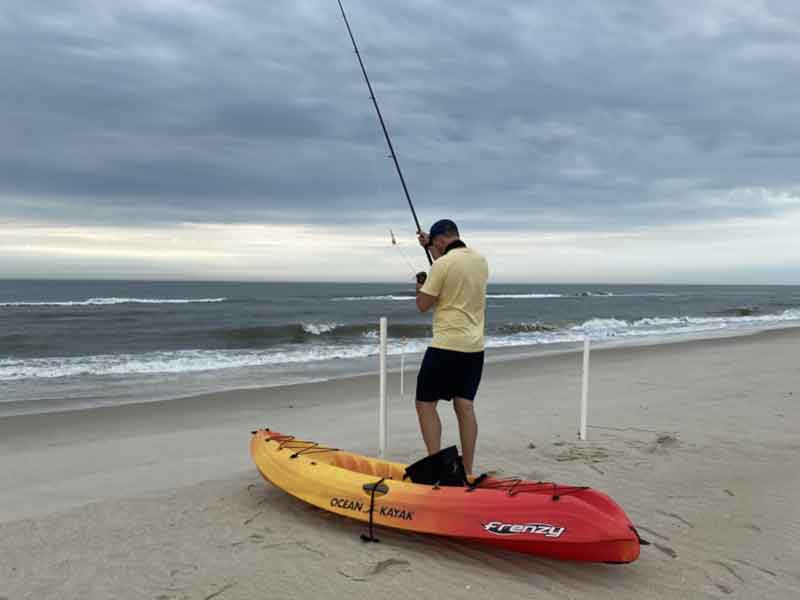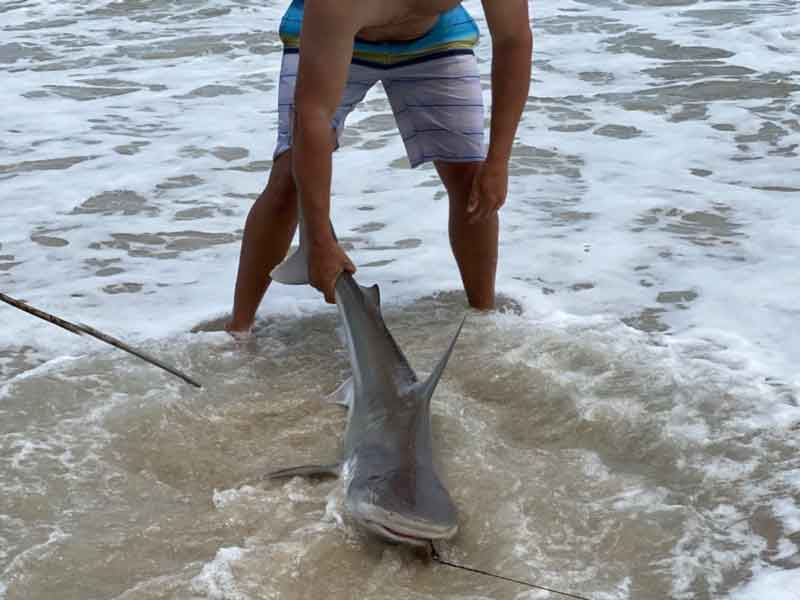It’s two in the morning and a white pickup truck rolls into my driveway, so I rub my eyes, grab my gear, and jump into the truck for our three-hour drive to the beaches of Assateague Island. I close my eyes and try to rest but my host is amped up and we start talking about our plans for the next two days: shark fishing.

This was my first attempt at shark fishing in the surf and Chris had the trip all planned out. We were to meet two other fishermen, one of whom has been fishing shark for several years. Chris had done his research and we had the gear to handle shark, including a kayak. Sharks and a kayak, you ask?
I soon found that there are several different methods to get your bait in front of a shark. The first method I learned was when I observed Jonathan Pistolas, a 14-year-old angler, catch a seven-plus-foot sand tiger shark. Jon has been fishing shark for the past three years and his method is to surf cast from the shoreline. The day before I met him, he had caught 25 sharks.
The second method was also revealed to me by Ken, who has been fishing for shark a few years as well. His method to get his bait beyond the breakers is to fire them using an air cannon. Yea, you heard me correctly, an air cannon. But this time of year the beach on Assateague Island where we were fishing would not permit the use of the air cannon, because of protected nesting birds.
The third method is a little trickier. First off, you need a stable kayak. We used a 10-foot Frenzy Ocean Kayak, although I saw several other types of kayak being used, too. Our objective was to get the bait out as close to 400 yards from the shoreline as possible. We attached the bait to one of the kayak’s shock cords, so it was within easy reach.
To get started you assign one team member to watch the rod and reel as line peels off, and another to act as a signalman. Don a lifejacket, and then drag the kayak out into the surf, with a shock cord attaching the paddle to the kayak. Drag the kayak beyond the breakers, pull yourself up onto it, retrieve the paddle, and paddle away. Head straight into the breakers — you don’t want to get sideways into them or you’ll be drinking a little salt water.
Once out there you look back at the shoreline, and wait for the signalman to let you know you’re out far enough. Then you drop the bait, and signal with your paddle that you dropped it so that the team on shore can start taking in slack. Here’s the fun part: you have to come to shore through the breakers, again not getting sideways. Once past that zone, you have to get off the kayak before you get thrown from it by a wave.
Okay: now that adrenaline rush is gone, but don’t relax too much. Next comes the bite, then getting a shark to shore, and safely releasing it. This is a team effort. We took turns on the fishing rod, with one angler controlling the shark, one angler dehooking the shark, and a fourth photographing the event.
If we had no bite for an extended period of time we would check the bait, but rather than reeling in 400 yards of line we would paddle out to check it. Using a three-foot piece of heavy mono fishing line with a carabiner attached to each end and clipped over the mainline, once you get to the end and the bait starts to lift off the bottom you simply pull it up and re-bait the hook if necessary.
On one of these trips, team member Jesse got into the kayak, clipped the carabiner to the fishing line, paddled out, and then turned right around and returned. When he got back and we asked if he’d changed the bait, he said “no” in his usual calm and controlled voice. We looked at each other, and then he said there was already a shark attached to the hook — and walked away to dry himself off and warm up, as we reeled in the shark.
This is a kayak adventure like no other, but it is serious business and safety must always come first. You are not only handling an apex predator, you’re in their water and should never shark fish alone. Ethical angling methods when fishing for shark also need to be taken into account, as this is almost entirely a catch-and-release fishery and there are regulations in place to protect the sharks. Be sure to read up on your state’s regulations and also on local regulations, as shark fishing from the beach is not legal in all areas.

Beach Kayak Shark Fishing Ethics
- Many species of sharks are protected and must be released immediately. If you’re not 100-percent sure what type of shark is on the end of the line, always let it go without hesitation.
- Do not drag a shark up onto the sand for a picture; not only is this illegal in some states, but the shark’s body is partially supported by the water. Struggling on dry sand can cause it internal injury.
- If you want pictures to document the catch, assign someone the role of photographer so that they can snap off a few shots as sharks are being released are un-hooked (carefully, and with long-nosed pliers, of course) as rapidly as possible.
- Use gear heavy enough to land the sharks quickly. Extended fights tire the fish and can reduce their chances of survival.
- By Eric Packard